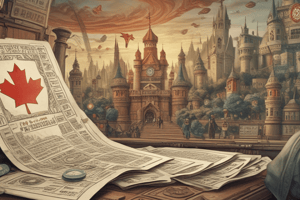Podcast
Questions and Answers
Which of the following is NOT a stage in the process of making a law in Canada?
Which of the following is NOT a stage in the process of making a law in Canada?
- Public Hearing (correct)
- Second Reading
- Committee Stage
- First Reading
The Judicial branch of government is responsible for creating new laws.
The Judicial branch of government is responsible for creating new laws.
False (B)
What is the primary purpose of the Youth Criminal Justice Act (YCJA)?
What is the primary purpose of the Youth Criminal Justice Act (YCJA)?
The YCJA aims to balance the consequences for youth who break the law while promoting rehabilitation and reintegration.
Lobby groups are groups of people who try to influence ______ and other individuals in public office.
Lobby groups are groups of people who try to influence ______ and other individuals in public office.
Match the following branches of government with their primary function:
Match the following branches of government with their primary function:
Political parties only represent a single viewpoint on political issues.
Political parties only represent a single viewpoint on political issues.
Which of the following is NOT an example of an advocacy group for youth justice?
Which of the following is NOT an example of an advocacy group for youth justice?
What is the final step in the Canadian law-making process?
What is the final step in the Canadian law-making process?
Which of the following groups are recognized for collective rights in Canada?
Which of the following groups are recognized for collective rights in Canada?
The judicial branch of the Canadian government is responsible for enforcing laws.
The judicial branch of the Canadian government is responsible for enforcing laws.
What is the primary purpose of the Indian Act?
What is the primary purpose of the Indian Act?
The ______ of 1763 formally established the treaty-making process in Canada.
The ______ of 1763 formally established the treaty-making process in Canada.
Match the following treaties with the provinces they involved:
Match the following treaties with the provinces they involved:
What was the fundamental exchange in the Numbered Treaties?
What was the fundamental exchange in the Numbered Treaties?
Section 16 of the Constitution Act, 1982 declares that English is the only official language of Canada.
Section 16 of the Constitution Act, 1982 declares that English is the only official language of Canada.
What does Scrip refer to?
What does Scrip refer to?
Flashcards
Parts of Parliament
Parts of Parliament
Legislature makes laws, executive enforces them, judicial interprets them.
Law Making Process in Canada
Law Making Process in Canada
A bill moves through readings, debates, committees, and gets royal assent.
Judicial Branch Responsibilities
Judicial Branch Responsibilities
Interprets laws, settles legal questions, hears cases of innocence or guilt.
Political Parties
Political Parties
Signup and view all the flashcards
Lobby Groups
Lobby Groups
Signup and view all the flashcards
YCJA Purpose
YCJA Purpose
Signup and view all the flashcards
YCJA Justice Method
YCJA Justice Method
Signup and view all the flashcards
Advocacy Groups for Youth
Advocacy Groups for Youth
Signup and view all the flashcards
Collective rights
Collective rights
Signup and view all the flashcards
Indian Act
Indian Act
Signup and view all the flashcards
Royal Proclamation of 1763
Royal Proclamation of 1763
Signup and view all the flashcards
Numbered Treaties
Numbered Treaties
Signup and view all the flashcards
Charter of Rights
Charter of Rights
Signup and view all the flashcards
Official languages of Canada
Official languages of Canada
Signup and view all the flashcards
Metis recognition
Metis recognition
Signup and view all the flashcards
Scrip
Scrip
Signup and view all the flashcards
Study Notes
The Working Parts of Parliament
- Parliament has three key branches: legislative (makes laws), executive (enforces laws), and judicial (interprets laws).
Lawmaking in Canada
- A bill is introduced in either the House of Commons or the Senate.
- It progresses through stages: First reading (introduction), Second reading (debate), Committee stage (detailed discussion), Report stage (returning to the chamber), passage in the other chamber, and Royal Assent (becoming law).
Role of the Judicial Branch
- The judiciary interprets laws, settles legal disputes, and determines guilt or innocence.
Political Parties
- Political parties coordinate candidates for elections.
- They often share similar political views.
Lobby Groups
- Lobby groups try to influence government officials.
Youth Criminal Justice Act (YCJA)
- Aims to balance consequences for youth crime.
- Prioritizes rehabilitation and reintegration, using alternatives to jail.
Advocacy Groups for Youth Justice
- Columbia Justice Lab, Centre for Children Law and Policy, Campaign for the fair sentencing of youth, The anti-recidivism Coalition, Coalition for Juvenile Justice are examples of youth justice advocacy groups in Alberta.
- They represent youth rights and work to guide youth through the system.
Individual and Collective Rights
- Individual and collective rights are protected.
- Recognized groups include Aboriginal peoples (First Nations, Métis, Inuit), Francophones, and Anglophones.
Judicial Role and Appeals
- Courts resolve legal conflicts.
- Appeals are made when a decision is believed to be in error.
Charter of Rights and Workers' Rights
- The Charter of Rights influences workers' rights by safeguarding individual and group rights obligations.
- Workplace discrimination is discouraged.
Indian Act
- The Indian Act (1876) governs registered Indians and reserve communities.
- Its main purpose is to regulate Indigenous peoples.
Treaty-Making Process
- The Royal Proclamation of 1763 established the formal treaty-making process.
Numbered Treaties
- Numbered Treaties (1871-1921) are agreements between First Nations and the Crown.
- Treaties 6, 7, and 8 impacted Alberta.
- These treaties included frameworks for land sharing and rights.
Official Languages
- Section 16 of the Constitution declares English and French as official languages in Canada and New Brunswick.
Charter of Rights and Francophone/Anglophone Rights
- English and French have equal status in Canadian Parliament, laws, and courts.
- Canadians have the right to communicate with federal institutions in their preferred official language.
Metis Recognition
- Section 35 of the Constitution Act, 1982, recognizes and affirms existing rights of Indian, Inuit, and Metis peoples.
- Scrip refers to documents entitling holders to land.
Studying That Suits You
Use AI to generate personalized quizzes and flashcards to suit your learning preferences.




